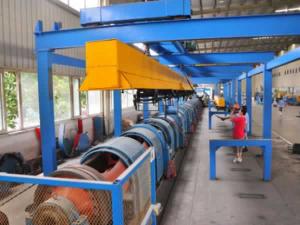
- Home
- Products
- Wire Drawing Machines
- Overhead Take-off Wire Drawing Machine
Overhead Take-off (OTO) Wire Drawing Machine
Description
The overhead take-off wire drawing machine is an adaptable piece of equipment for drawing various metal wires. The wire drawing machinery is suited for the drawing of steel wire, welding wire, zinc coated steel wire and alloy wires. It can be equipped with a 630-800 spool take-up or trunk type take-up machine.
Note: drawing passes and drum diameter can be designed according to requirements of the buyer.
Processes
Pay-off → Shell cleaning (pre-processing)→ Wire rod pointing → (Butt welding) → Drawing wire → Take-up (spool or trunk take-up).

Main Characteristics
1. The wire drawer is made up of a main reduction box, die casing, wheel frame, wire brace and electrical control system. The spinning drawing blocks are driven by JZT or Y series motor. The drawing blocks are fixed vertically within the sealed box body.
2. The safety halt gear is installed close to the operation block.
| Model | ||||||
| LW1-6/560 | 560mm | 6.5-4.4mm | 2.5-1.76mm | 300m/min | 18.5-22KW | 2000KG |
| LW1-6/550 | 550mm | 6.5mm | 2.5mm | 294m/min | 15-22KW | 1400KG |
| LW1-6/450 | 450mm | 4mm | 1.6mm | 280m/min | 7.5-15KW | 1100KG |
| LW1-6/350 | 350mm | 2.6-1.5mm | 1.2-0.7mm | 227m/min | 5.5KW | 700KG |
An Overhead Take-off Wire Drawing Machine (also known as a "bull block" or "pulling machine") is another type of industrial equipment used to draw wire. This machine operates by pulling the wire through a series of dies, just like a straight line drawing machine. However, in an overhead take-off machine, the wire is not gripped by capstans; instead, it is pulled through the dies by a set of rollers or blocks that run on an overhead track.
The wire is typically fed into the machine from one end and pulled through the dies by the rollers at the other end. As the wire passes through each die, its diameter is reduced and its length is increased. The process can be repeated several times until the desired diameter and length are achieved.
Overhead take-off machines are often used for drawing larger-diameter wires, such as those used in the production of cables, ropes, and fencing. They are also used in the manufacture of certain types of springs and mechanical components.







